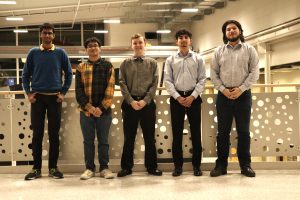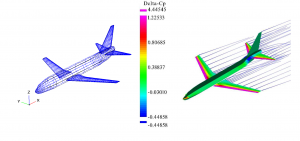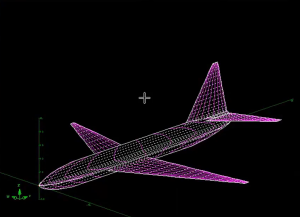About the Aircraft Performance Team
The Aircraft Performance Team’s goals for the Spring 2023 semester is to research different aspects of the truss-braced wing design to maximize the efficiency of the AL-37. The main deliverable for aircraft performance team is to complete test flights with the new wing and create accompanying reports.
The aircraft performance team consists of team lead Sanketh Narmnada with members Bryce Kari, Sarthak Satpathy, Jovanni Balley, and Christian Chiugan.

Left to Right: Sarthak Satpathy, Sanketh Narmnada (team lead), Bryce Kari, Jovanni Balley, Christian Chiugan
4/14 Update:
After trying to experiment with SUAVE, the team decided there were too many software issues to learn how to optimize the wing design for the project’s needs. As a result, the team began looking for alternative solutions. The following were considered:
- Switching back to the traditional CAD and CFD approach
- Learning and utilizing completely a new alternative piece of software
The team decided to take another risk by learning a new software as OpenVSP. This risk paid off as the team almost immediately found OpenVSP easy to learn and utilize. OpenVSP (Open Vehicle Sketch Pad) is an open-source parametric aircraft geometry tool originally developed by NASA. Typically, OpenVSP is used to create preliminary 3D models for engineering analyses. At first, all the members focused on creating a simple Boeing 737 model, which can be seen below.

Initial 737 test model and preliminary pressure analysis
The main objective that the team was trying to get out of utilizing OpenVSP was to find optimal dimensions for the sizing of a truss-braced wing that could be mounted to the AL37. However, the team needed to change structure as priorities shifted toward getting ready for the upcoming test flight. So, one member was focused on obtaining a rough optimal solution for the dimensional parameters, while the others were focused on creating a Pilot’s Operating Handbook for the new wing that the development team is manufacturing (due to the changing flight characteristics). Regarding the truss-braced wing optimization, an algorithm was developed to run numerous iterations of OpenVSP to obtain plots of different flight parameters. The correlations found in this data will help make decisions on which parts of the wing affect the aircraft’s performance the most and how the team could improve the wing to fit the project’s needs. The following is a comparison between the first iteration and the final iteration.

First iteration (left) vs last iteration (right)
Team Reflection
Overall, the aircraft performance team has done an amazing job adapting to changing situations. A lot of the members had a lot to learn over the semester and put lots of time as well as effort into learning more about the optimizing processes that the team has done. The team’s main challenge was trying to learn Python to utilize SUAVE (a software with very little documentation) and trying to troubleshoot the many issues that the program had. Once the team got past that by switching the main software to OpenVSP, the team got much more information out of the optimization process than ever before. The big lesson learned from this semester was not to spend too much time on software that does not work for the team. At first, the team was intimidated by the idea of starting from scratch and learning OpenVSP, especially after the team had invested so much time into learning SUAVE. However, the team will be able to transfer the appropriate data over to the development team to meet our deliverables because we decided to switch just in time. This is a lesson that the team will document so future members avoid making the same mistake.
Future Plans
For the future, the team is looking to conduct its flight test sometime in the next two weeks and write an accompanying report for it. The team is also looking to solidify the dimensional parameters of the truss-braced wing so that the development team can have something to work off of when manufacturing it in a future semester. The team is also pushing to learn more about OpenVSP and plans to have documentation in the future.
Earlier in the semester:
Researching with the goal of implementing the truss-braced wing required the team to research and implement a design approach to optimize different aspects of aircraft design. Through trial and error, the team investigated the traditional CAD design and CFD analysis process. Seeing that the process was slow and could be improved, the focus shifted towards an open sourced program known as SUAVE (by Stanford University). A few members were researching the program well prior to this point and found that the program had its issues, mainly being python based. This required the team to learn some object-oriented python, which led to further comprehension of the issues faced team members.

AVL model of a 737 tutorial that was created through SUAVE
Future Plans
In the near future, the team plans to run more sophisticated analyses based on the wing designs that are deemed optimized by running SUAVE analyses with desired input parameters. The project recently placed an order for another AL-37 aircraft and the team plans to assemble it during the week of March 6th. The team also plans to begin carrying out test flights and creating reports towards the end of March.
Past Semesters
Fall 2022
The Aircraft Performance Team’s goals for the Fall 2022 semester are to continue the progress made from Spring 2022 semester. The team is currently responsible for preparing the AL37 aircraft for two test flights. Each test flight will test the aircraft’s ability of collecting a specific flight parameter. For the first flight, the parameter that was tested was rate of climb.
Update 11/18: The parameter for the second flight has been determined to be the battery drain rate for the new 2-battery system. The integration of the Pixhawk 4 autopilot system will also be tested in the second flight. Due to unfavorable conditions, the second flight has been delayed. In the mean time, the team has been working on obtaining stability derivatives for the aircraft with advice from faculty advisor Dr. Sherman and technical advisor Rohan Sharma. Along with this, the team is beginning to compile all information from every AL-37 flight into an overall report.
Fall 2021
The Tech Team’s goals for the Fall 2021 semester were to prepare the Pixhawk 4 for flight with the new AL37 aircraft, continue with the parametric sizing code from previous semesters, research future wing configurations, and optimize wiring and electronics systems for the carbon-fiber truss-braced aircraft.
The team’s goals for this semester are to finish integrating the Pixhawk to the AL37 aircraft, investigate the issue of energy consumption from the previous flight, and conduct post-flight data analysis with QGroundControl and MATLAB code. The team will also work with the Build/Development Team to determine a new airfoil for the truss wings. The team will also begin re-investigating the carbon fiber truss-braced aircraft, as we ll as readying a UMX Aero Commander the project ordered around 2019 for flight training use. The semester will end off with a post-flight report detailing and discussing the data analysis results.
Tech Team members consist of the team leader Jacob Carlson and members Moksh Jani, Bryce Kari, Sanketh Narmnada, Brandon Reyes, & Matthew Webb.
4/29 Update: End of Semester Recap:
The Tech Team was tasked with improving the electronics setup of the aircraft over the semester. One change is the modification of the electronics setup to allow more connections to the power distribution board, which enabled the landing gear to be fully operational for flight tests. Another change is the implementation of a system to monitor battery levels and GPS data in-flight, utilizing the Pixhawk 4. This enabled the project to visualize data such as the discharge rate to better understand discovered issues with the battery. The positioning data allowed the group to further understand the behavior of the aircraft during flight, which will assist the group with future flight tests. The team also finished the installation of a pitot tube to gather pressure data. This allowed the team to gather further information about the aircraft that had not been recorded, such as airspeed and enables the group to conduct flight tests to gather different forms of data. The team also developed a flight report template and discovered means to read files from the flight control unit to better process the data.